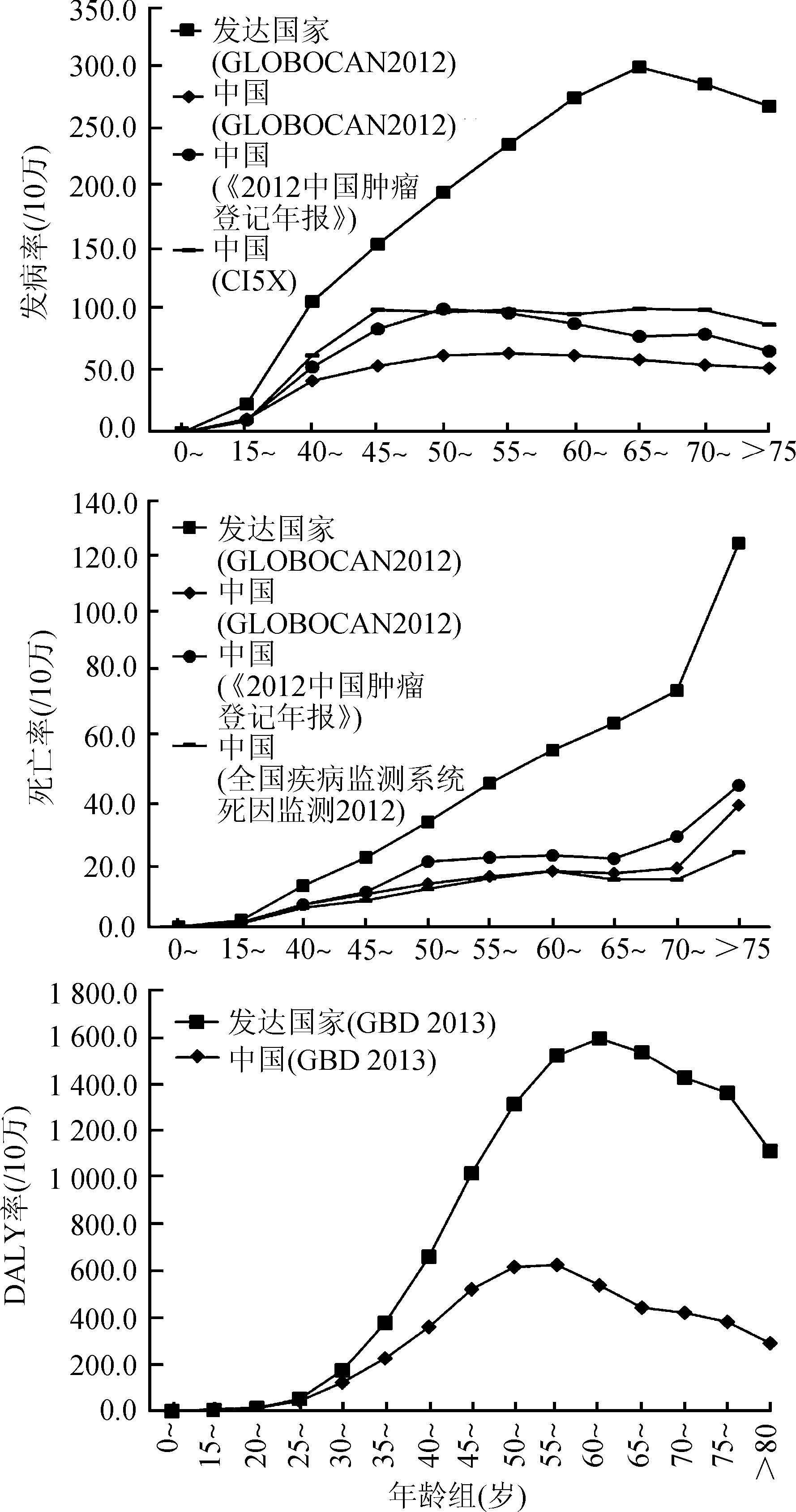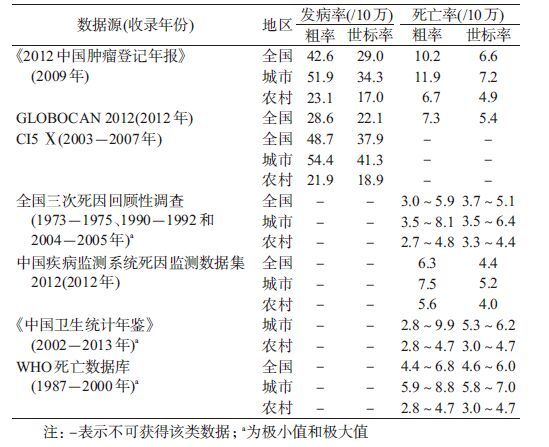文章信息
- 王乐, 张玥, 石菊芳, 代敏.
- Wang Le, Zhang Yue, Shi Jufang, Dai Min.
- 中国女性乳腺癌疾病负担分析
- Disease burden of famale breast cancer in China
- 中华流行病学杂志, 2016, 37(7): 970-976
- Chinese Journal of Epidemiology, 2016, 37(7): 970-976
- http://dx.doi.org/10.3760/cma.j.issn.0254-6450.2016.07.013
-
文章历史
- 投稿日期: 2015-12-31
2. 100026 首都医科大学附属北京妇产医院
2. Beijing Obstetrics and Gynecology Hospital, Capital Medical University, Beijing 100026, China
乳腺癌是严重威胁女性健康的恶性肿瘤[1]。2012年全球乳腺癌新发和死亡病例分别为1 671 149例和521 907例,其中我国分别占11.2%和9.2%[2],乳腺癌成为我国女性发病首位的恶性肿瘤[3]。目前国内外乳腺癌疾病负担研究数据存在差异[4, 5],为此本研究在前期系统分析5个结直肠癌疾病负担数据源基础上[4],又以乳腺癌为目标癌种,将数据源扩展至8个,分析我国人群乳腺癌的发病率(数)、死亡率(数)和伤残调整生命年(DALY)等疾病负担数据,以了解我国人群乳腺癌疾病负担现况与发展趋势。
资料与方法1. 资料来源:除前期纳入的《2012 中国肿瘤登记年报》数据[6]、全国三次死因回顾性调查[7, 8, 9]、国际癌症研究署(IARC)网络数据库GLOBOCAN 2012[2]、五大洲癌症发病率(Cancer Incidence in Five Continents,CI5)[10, 11, 12, 13, 14, 15, 16]和WHO死亡率数据库[17]外,本次研究还纳入了《全国疾病监测系统死因监测数据集 2012》[18]、《中国卫生统计年鉴》中居民病伤死亡原因统计数据[19, 20, 21, 22, 23, 24, 25, 26, 27, 28, 29, 30]以及美国华盛顿大学健康计量与评估研究中心牵头以DALY为主要指标进行综合评价的全球疾病负担(Global Burden of Disease,GBD)[31, 32]数据。主要数据指标包括发病率、死亡率、DALY及其细化指标早死损失寿命年(YLL)和伤残损失寿命年(YLD)。
2. 数据处理:摘录上述8个数据源资料中乳腺癌相关发病率(数)和死亡率(数),包括全国总体、分城乡、分年龄人群等细化数据,以及GBD 2013发布的1990-2013年我国和分省份的DALY、YLL、YLD和年龄别DALY率。乳腺癌发病和死亡粗率,根据世界人口标准年龄构成计算标化率(世标率)[32];为实现不同数据来源的年龄别疾病负担比较,本研究将部分数据源合并为8个年龄段(0~14、15~39、40~45、50~59、60~65、65~69、70~75及>75岁)。
3. 统计学分析:分别整合CI5 Ⅳ~Ⅹ卷(1973-2007年)、全国三次死因回顾性调查(1973-2005年)和GBD 2013项目数据,分析乳腺癌发病率、死亡率和DALY的时间趋势。对WHO死亡数据库和《中国卫生统计年鉴》中死亡数据,利用Joinpoint Trend Analysis Software 4.2.0.2软件进行时间趋势分析,采用对数线性回归模型计算不同时间段的年度变化百分比(APC)和APC的加权平均值平均年度变化百分比(AAPC),检验水准α=0.05[33, 34]。考虑《中国卫生统计年鉴》中城市构成可能影响死亡率时间趋势,本文对大城市赋予80%的比重计算校正死亡率后再进行分析[35]。采用GLOBOCAN 2012在线平台摘录2012-2035年我国乳腺癌发病例数与死亡例数,预测我国乳腺癌疾病负担趋势。
结 果1. 资料基本特征: 上述8个资料数据源基本信息见表1。
2. 历史数据:CI5第Ⅹ卷显示2003-2007年全国12个肿瘤登记点的乳腺癌发病率为37.9/10万,且城市是农村的2.2倍(表2),年龄别发病率在40岁开始明显上升,45~49岁达到峰值后降低,70~74岁出现第二个峰值后逐渐下降(图1);发病长期趋势显示,上海市(CI5中我国唯一最早且连续收录的登记点)1973-2007年女性发病粗率增加208.8%(图2)。1973-1975、1990-1992和2004-2005年分别开展的全国三次死因回顾性调查,显示乳腺癌死亡率为3.7/10万~5.1/10万,对应城乡死亡比为1.3~1.7(表2);乳腺癌死亡率呈上升趋势,全国总体、城乡死亡粗率分别增加100.0%、127.4%和75.2%(图2)。进一步细化时间趋势采用Joinpoint分析显示,1987-2000年(WHO死亡数据库)全国乳腺癌死亡粗率AAPC为3.1%(95%CI:2.3%~3.9%),城乡AAPC分别为3.1%(95%CI:2.0%~4.2%)和3.5%(95%CI:1.8%~5.2%),对应世标率AAPC值有所降低,但总体趋势一致(表3)。

|
| 图1 中国女性乳腺癌疾病负担的年龄别分布 (以发达国家为参照) |

|
| 图2 中国女性乳腺癌疾病负担的时间趋势 |
3. 现况:《2012中国肿瘤登记年报》显示,2009年肿瘤登记地区乳腺癌发病率与死亡率分别是29.0/10万和6.6/10万;城乡发病比为2.0,死亡比为1.5(表2);年龄别发病率峰值在50~54岁和70~74岁,死亡率随年龄增加逐渐升高(图1)。GLOBOCAN 2012项目估计2012年全国乳腺癌发病率和死亡率分别为22.1/10万和5.4/10万,明显低于发达国家(表2);年龄别发病率在40岁开始明显上升,于45~59岁达到峰值后平缓降低,死亡率随年龄增加逐步上升(图1)。《全国疾病监测系统死因监测数据集2012》显示,2012年全国死亡率为4.4/10万,城乡比为1.3(表2)。进一步细化时间趋势采用Joinpoint分析显示,《中国卫生统计年鉴》中2002-2013年城市人群死亡粗率AAPC为2.7%(95%CI:0.9%~4.5%),农村人群未见明显变化(P>0.05);经年龄标化后,城乡APCC值均未见明显变化(P>0.05),见表3。
4. 未来预测:GLOBOCAN 2012将年龄别发病和死亡率与人口增长相结合,对2012-2035年中国乳腺癌发病与死亡例数进行预测。2035年估计我国乳腺癌发病例数将达到251 690例,比2012年增加34.4%,其中>65岁人群增幅(139.1%)高于≤65岁人群(11.2%);死亡例数将达到75 875例,较2012年增加58.1%,>65岁人群增幅更为明显(134.9%),与发病例数相一致(图3)。

|
| 图3 中国女性乳腺癌疾病负担的发病与死亡例数预测(源自GLOBOCAN 2012) |
5. DALY相关分析:GBD 2013报告2013年中国女性乳腺癌DALY为166.6(95%CI:130.7~206.7)万人年,占全球12.7%;与1990年相比,DALY、YLL和YLD分别增加56.8%、50.4%和182.3%(图2)。其中50~59岁是我国女性乳腺癌所致DALY率的峰值年龄,较发达国家提前5~10岁(图1)。2013年YLD占DALY比重的全国平均水平为8.7%,分省份分析显示波动幅度较小(最低为重庆市 8.1%,最高为青海省9.0%);按照2015中国统计年鉴的行政区域划分[36],东部地区的YLD占DALY比重低于全国平均水平的省份最多,中部和西部地区在平均水平上下分布较均衡,东北三省均在平均水平以下(图4)。

|
| 图4 中国女性乳腺癌疾病负担的分省份YLD占DALY比重(源自GBD 2013) |
本研究基于国内外8个数据源资料中整理我国乳腺癌发病、死亡和DALY等数据,分析女性乳腺癌疾病负担的历史、现况及未来趋势。自20世纪70年代后的30多年来,我国女性乳腺癌死亡率翻了1倍,且城市人群大于农村。目前乳腺癌依然是我国女性主要的恶性肿瘤,其造成的疾病负担较重,全国乳腺癌发病率、死亡率分别是22.1/10万和5.4/10万,因其损失的DALY达到166.6万人年,城市高于农村,高发年龄在45~59岁。将来随着我国城市化及人口老龄化的进程加快,乳腺癌疾病负担将继续加重。
数据资料显示,城市地区乳腺癌发病率和死亡率均高于农村,城乡比分别约是2和1.5。长期趋势分析显示,1973-2005年城市乳腺癌死亡粗率增加趋势大于农村,分别增加127.4%和75.2%;进一步细化时间采用Joinpoint趋势分析,1989-2000年农村死亡率AAPC稍大于城市,2002-2013年城市AAPC增加明显(P<0.05),农村无明显变化(P>0.05)。《2012中国肿瘤登记年报》数据显示2000-2011年女性乳腺癌发病与死亡均明显增加[37]。乳腺癌发病率与诊疗水平均能影响其死亡率,有研究报道城乡乳腺癌5年生存率分别为77.8%和55.9%[38],而农村女性乳腺癌确诊时在中晚期居多[39],提示发病率的增加对城市死亡率影响较大,而农村死亡率的变化可能与缺乏有效的诊疗手段有关。
分析还显示,不同时期,乳腺癌的年龄别发病曲线有所改变。2003-2007年我国乳腺癌发病率在40岁起明显升高,45~49岁和70~74岁分别出现峰值;2009年该峰值年龄后移,双峰现象仍存在;但2012年仅在55~59岁出现峰值,双峰现象消失。年龄发病模式的改变可能与人口老龄化和社会生活方式改变等因素有关[40, 41]。国外研究已证实,通过乳腺癌筛查项目有利于发现早期病例并可降低50~69岁女性的死亡率[42, 43]。我国女性乳腺癌高发年龄是55~59岁,较发达国家(65~69岁)提前约10年,结合癌前病变发生提前10~15年[44],提示我国乳腺癌筛查目标起始年龄可能应更早。目前已开展的大规模乳腺癌筛查项目有两项,2009年开展的农村妇女“两癌”筛查项目选择35岁为筛查起始年龄[45],2012年中央转移支付的重大公共卫生项目——城市癌症早诊早治项目包含乳腺癌在内的六大癌种筛查项目选择40岁为起始年龄[46]。但筛查起始年龄如何且其筛查效果更好以及是否更经济有效,仍有待进一步研究证实。
GBD 2013项目是唯一以DALY呈现疾病负担的数据源。分析显示,我国女性乳腺癌的DALY逐年增加。但与GBD 2010发表的结果有差异[47, 48],其原因可能是我国的数据更新和分析方法的调整[49, 50]。中国女性乳腺癌YLD占DALY的比重逐渐增加,提示因患乳腺癌造成的健康生命年的损失应引起重视。同时全国各省份比重波动幅度较小,且东中西部行政区域间差异较小,可能原因是测量失能权重参数时纳入我国人群样本比例较少(<1%)[51]。
本研究存在不足。首先,分析资料中由于国内数据其覆盖人口、收录年份及选用指标等不同,加之国外数据库收录的国内不同数据来源,不可避免造成分析结果存在差异;其次不同数据库公开的信息有限,本文采用数据的时间跨度、结果呈现形式等与已有研究存在交叉[52, 53],如最新肿瘤登记年报收录2009年数据,而文献报道的数据已包括2011年的分析结果[3];再有本文分析的8个数据源中不包括临床分期信息(含癌前病变)、生存预后情况及其造成的经济负担等数据。
综上所述,无论是过去还是将来,乳腺癌对我国女性造成的疾病负担较重;其中城市地区及55~59岁女性应作为重点防控人群。目前以DALY为指标的疾病负担数据有限,且不同地区的量化结果差别较小,建议进一步深入开展DALY及YLD相关精细研究。
利益冲突 无
| [1] Stewart BW,Wild CP. World cancer report 2014[M]. France:WHO Press,2014:17-27. |
| [2] Ferlay J,Soerjomataram I,Ervik M,et al. GLOBOCAN 2012 v1.0,cancer incidence and mortality worldwide:IARC Cancer Base No.11[EB/OL].[2015-11-05]. http://globocan.iarc.fr. |
| [3] 陈万青,郑荣寿,曾红梅,等. 2011年中国恶性肿瘤发病和死亡分析[J]. 中国肿瘤,2015,24(1):1-10. DOI:10.11735/j.issn.1004-0242.2015.01.A001. Chen WQ,Zheng RS,Zeng HM,et al. Report of cancer incidence and mortality in China,2010[J]. Chin Cancer,2015,24(1):1-10. DOI:10.11735/j.issn.1004-0242.2015.01.A001. |
| [4] 张玥,石菊芳,黄慧瑶,等. 中国人群结直肠癌疾病负担分析[J]. 中华流行病学杂志,2015,36(7):709-714. DOI:10.3760/cma.j.issn.0254-6450.2015.07.010. Zhang Y,Shi JF,Huang HY,et al. Burden of colorectal cancer in China[J]. Chin J Epidemiol,2015,36(7):709-714. DOI:10.3760/cma.j.issn.0254-6450.2015.07.010. |
| [5] 石菊芳,张玥,曲春枫,等. 以伤残调整生命年为指标的中国人群癌症疾病负担现状[J].中华预防医学杂志,2015,49(4):365-369. DOI:10.3760/cma.j.issn.0253-9624.2015.04.019. Shi JF,Zhang Y,Qu CF,et al. Burden of cancer in China:data on disability-adjusted life years[J].Chin J Prev Med,2015,49(4):365-369. DOI:10.3760/cma.j.issn.0253-9624.2015.04.019. |
| [6] 赫捷,陈万青. 2012中国肿瘤登记年报[M]. 北京:军事医学科学院出版社,2012:122-153. He J,Chen WQ. 2012 Chinese cancer registry annual report[M]. Beijing:Military Academy of Medical Sciences Press,2012:122-153. |
| [7] 全国肿瘤防治研究办公室. 中国恶性肿瘤死亡率调查研究(1973-1975)[M]. 北京:人民卫生出版社,1979:250-266. National Office for Cancer Prevention and Control. Investigate for malignant tumor mortality in China (1973-1975)[M]. Beijing:People's Medical Publishing House,1979:250-266. |
| [8] 李连弟,陈育德. 中国恶性肿瘤死亡调查研究(1990-1992)[M]. 北京:人民卫生出版社,2008:136-147. Li LD,Chen YD. Investigate for malignant tumor mortality in China (1990-1992)[M]. Beijing:People's Medical Publishing House,2008:136-147. |
| [9] 赵平,孔灵芝.中国肿瘤死亡报告:全国第三次死因回顾抽样调查[M]. 北京:人民卫生出版社,2010:120-131. Zhao P,Kong LZ. Report on tumor mortality in China[M]. Beijing:People's Medical Publishing House,2010:120-131. |
| [10] Forman D,Bray F,Brewster DH,et al. Cancer incidence in five continents[M]. Vol.Ⅹ. Lyon:IARC Scientific Publication,2014:1073-1077. |
| [11] Curado MP,Edwards B,Shin HR,et al. Cancer incidence in five continents[M]. Vol.Ⅸ. Lyon:IARC Scientific Publication,2007:534-537. |
| [12] Parkin DM,Whelan SL,Ferlay J,et al. Cancer incidence in five continents[M]. Vol. Ⅷ. Lyon:IARC Scientific Publication,2002. |
| [13] Parkin DM,Whelan SL,Ferlay J,et al. Cancer incidence in five continents[M]. Vol. Ⅻ. Lyon:IARC Scientific Publication,1997. |
| [14] Parkin DM,Muir CS,Whelan SL,et al. Cancer incidence in five continents[M]. Vol.Ⅵ. Lyon:IARC Scientific Publication,1992. |
| [15] Muir CS,Waterhouse J,Mack T,et al. Cancer incidence in five continents[M]. Vol.Ⅴ. Lyon:IARC Scientific Publication,1987. |
| [16] Waterhouse J,Muir CS,Shanmugaratnam K,et al. Cancer incidence in five continents[M]. Vol. Ⅳ. Lyon:IARC Scientific Publication,1982. |
| [17] World Health Organization. Mortality database[EB/OL]. (2013-12-20)[2015-11-20]. http://www.who.int/healthinfo/statistics/mortality_rawdata/en/. |
| [18] 中国疾病预防控制中心慢性非传染性疾病预防控制中心. 全国疾病监测系统死因监测数据集2012[M]. 北京:科学普及出版社,2013:78-117. The Chinese Center for Chronic and Noncommunicable Disease Control and Prevention,Chinese Center for Disease Control and Prevention. Monitoring datasets of national disease surveillance system 2012[M]. Beijing:Popular Science Press,2013:78-117. |
| [19] 中华人民共和国卫生部. 2003中国卫生统计年鉴[M]. 北京:中国协和医科大学出版社,2003:199-250. Ministry of Health of the People's Republic of China. 2003 China health statistics yearbook[M]. Beijing:Peking Union Medical College Press,2003:199-250. |
| [20] 中华人民共和国卫生部. 2004中国卫生统计年鉴[M]. 北京:中国协和医科大学出版社,2004:223-272. Ministry of Health of the People's Republic of China. 2004 China health statistics yearbook[M]. Beijing:Peking Union Medical College Press,2004:223-272. |
| [21] 中华人民共和国卫生部. 2005中国卫生统计年鉴[M]. 北京:中国协和医科大学出版社,2005:255-306. Ministry of Health of the People's Republic of China. 2005 China health statistics yearbook[M]. Beijing:Peking Union Medical College Press,2005:255-306. |
| [22] 中华人民共和国卫生部. 2006中国卫生统计年鉴[M]. 北京:中国协和医科大学出版社,2006:259-308. Ministry of Health of the People's Republic of China. 2006 China health statistics yearbook[M]. Beijing:Peking Union Medical College Press,2006:259-308. |
| [23] 中华人民共和国卫生部. 2007中国卫生统计年鉴[M]. 北京:中国协和医科大学出版社,2007:253-304. Ministry of Health of the People's Republic of China. 2007 China health statistics yearbook[M]. Beijing:Peking Union Medical College Press,2007:253-304. |
| [24] 中华人民共和国卫生部. 2008中国卫生统计年鉴[M]. 北京:中国协和医科大学出版社,2008:227-278. Ministry of Health of the People's Republic of China. 2008 China health statistics yearbook[M]. Beijing:Peking Union Medical College Press,2008:227-278. |
| [25] 中华人民共和国卫生部. 2009中国卫生统计年鉴[M]. 北京:中国协和医科大学出版社,2009:265-361. Ministry of Health of the People's Republic of China. 2009 China health statistics yearbook[M]. Beijing:Peking Union Medical College Press,2009:265-361. |
| [26] 中华人民共和国卫生部. 2010中国卫生统计年鉴[M]. 北京:中国协和医科大学出版社,2010:273-324. Ministry of Health of the People's Republic of China. 2010 China health statistics yearbook[M]. Beijing:Peking Union Medical College Press,2010:273-324. |
| [27] 中华人民共和国卫生部. 2011中国卫生统计年鉴[M]. 北京:中国协和医科大学出版社,2011:287-341. Ministry of Health of the People's Republic of China. 2011 China health statistics yearbook[M]. Beijing:Peking Union Medical College Press,2011:287-341. |
| [28] 中华人民共和国卫生部. 2012中国卫生统计年鉴[M]. 北京:中国协和医科大学出版社,2012:267-294. Ministry of Health of the People's Republic of China. 2012 China health statistics yearbook[M]. Beijing:Peking Union Medical College Press,2012:267-294. |
| [29] 国家卫生和计划生育委员会. 2013中国卫生统计年鉴[M]. 北京:中国协和医科大学出版社,2013:291-320. The National Health and Family Planning Commission. 2013 China health statistics yearbook[M]. Beijing:Peking Union Medical College Press,2013:291-320. |
| [30] 国家卫生和计划生育委员会. 2014中国卫生统计年鉴[M]. 北京:中国协和医科大学出版社,2014:281-310. The National Health and Family Planning Commission. 2014 China health statistics yearbook[M]. Beijing:Peking Union Medical College Press,2014:281-310. |
| [31] Institute for Health Metrics and Evaluation. Global burden of disease project[EB/OL].[2016-01-10]. http://www.healthmetricsandevaluation.org/gbd. |
| [32] Segi M. Cancer mortality for selected sites in 24 countries (1950-57)[M]. Sendai:Tohuku University School of Public Health,1960. |
| [33] Division of Cancer Control and Population Sciences of National Cancer Institute. Joinpoint trend analysis software,version 4.2.0.2[EB/OL]. (2015-06-23)[2015-10-09]. http://surveillance.cancer.gov/joinpoint/. |
| [34] Kim HJ,Fay MP,Feuer EJ,et al. Permutation tests for joinpoint regression with applications to cancer rates[J]. Stat Med,2000,19(3):335-351. |
| [35] 王艳红,李立明,李天霖. 《全国卫生统计年报/鉴》1987-2003年资料可靠性评价[J]. 中华流行病学杂志,2007,28(2):195-198. Wang YH,Li LM,Li TL. Evaluation on the reliability of the national health statistical yearbooks,1987-2003[J]. Chin J Epidemiol,2007,28(2):195-198. |
| [36] 国家统计局. 2015中国统计年鉴[EB/OL].[2015-11-09].http://www.stats.gov.cn/tjsj/ndsj/2015/indexch.htm. National Bureau of Statistics. China statistics yearbook 2015[EB/OL].[2015-11-09]. http://www.stats.gov.cn/tjsj/ndsj/2015/indexch.htm. |
| [37] Chen WQ,Zheng R,Baade PD,et al. Cancer statistics in China,2015[J]. CA Cancer J Clin,2016,1. DOI:10.3322/caac.21338.[Epub ahead of print] |
| [38] Zeng HM,Zheng RS,Guo Y,et al. Cancer survival in China,2003-2005:a population-based study[J]. Int J Cancer,2015,136(8):1921-1930. DOI:10.1002/ijc.29227. |
| [39] Wang Q,Li J,Zheng S,et al. Breast cancer stage at diagnosis and area-based socioeconomic status:a multicenter 10-year retrospective clinical epidemiological study in China[J]. BMC Cancer,2012,12(1):122. DOI:10.1186/1471-2407-12-122. |
| [40] Linos E,Spanos D,Rosner BA,et al. Effects of reproductive and demographic changes on breast cancer incidence in China:a modeling analysis[J]. J Natl Cancer Inst,2008,100(19):1352-1360. DOI:10.1093/jnci/djn305. |
| [41] Lee H,Li JY,Fan JH,et al. Risk factors for breast cancer among Chinese women:a 10-year nationwide multicenter cross-sectional study[J]. J Epidemiol,2014,24(1):67-76. DOI:org/10.2188/jea.JE20120217. DD |
| [42] Gøtzsche PC,Jørgensen KJ. Screening for breast cancer with mammography[J]. Cochrane Database Syst Rev,2013. DOI:10.1002/14651858.CD001877. |
| [43] Lauby-Secretan B,Scoccianti C,Loomis D,et al. Breast-cancer screening-viewpoint of the IARC Working Group[J]. N Engl J Med,2015,372(24):2353-2358. DOI:10.1056/NEJMsr 1504363. |
| [44] Hartmann LC,Radisky DC,Frost MH,et al. Understanding the premalignant potential of atypical hyperplasia through its natural history:a longitudinal cohort study[J]. Cancer Prev Res,2014,7(2):211-217. DOI:10.1158/1940-6207.CAPR-13-0222. |
| [45] 国家计划生育委员会,卫生部,全国妇联关于印发《农村妇女"两癌"检查项目管理方案》的通知[EB/OL]. (2009-06-30)[2015-11-09]. http://www.nhfpc.gov.cn/fys/s3581/200906/cd3c33a7ad624a50b8100b262041dabe.shtml. The National Family Planning Commission,Notice of the Ministry of Health and the National Women's Federation on the issuance of rural women two cancer screening program management[EB/OL].(2009-06-30)[2015-11-09]. http://www.nhfpc.gov.cn/fys/s3581/200906/cd3c33a7ad624a50b8100b262041dabe.shtml. |
| [46] 代敏,石菊芳,李霓. 中国城市癌症早诊早治项目设计及预期目标[J]. 中华预防医学杂志,2013,47(2):179-182. DOI:10.3760/cma.j.issn.0253-9624.2013.02.018. Dai M,Shi JF,Li N. The design and expectation of cancer screening program in urban China[J].Chin J Prev Med,2013,47(2):179-182. DOI:10.3760/cma.j.issn.0253-9624.2013.02.018. |
| [47] Yang G,Wang Y,Zeng Y,et al. Rapid health transition in China,1990-2010:findings from the Global Burden of Disease Study 2010[J]. Lancet,2013,381(9882):1987-2015. DOI:10.1016/S0140-6736(13)61097-1. |
| [48] 刘韫宁,刘江美,殷鹏,等. 1990年与2010年中国恶性肿瘤疾病负担研究[J]. 中华预防医学杂志,2015,49(4):309-314. DOI:10.3760/cma.j.issn.0253-9624.2015.04.006. Liu YN,Liu JM,Yin P,et al. The disease burden of malignant tumor in China,1990 and 2010[J].Chin J Prev Med,2015,49(4):309-314. DOI:10.3760/cma.j.issn.0253-9624.2015.04.006. |
| [49] Naghavi M,Wang H,Lozano R,et al. Global,regional,and national age-sex specific all-cause and cause-specific mortality for 240 causes of death,1990-2013:a systematic analysis for the Global Burden of Disease Study 2013[J]. Lancet,2015,385(9963):117-171. DOI:0.1016/S0140-6736(14)61682-2. |
| [50] Vos T,Barber RM,Bell B,et al. Global,regional,and national incidence,prevalence,and years lived with disability for 301 acute and chronic diseases and injuries in 188 countries,1990-2013:a systematic analysis for the Global Burden of Disease Study 2013[J]. Lancet,2015,386(9995):743-800. DOI:10.1016/S0140-6736(15)60692-4. |
| [51] Salomon JA,Haagsma JA,Davis A,et al. Disability weights for the global burden of disease 2013 study[J]. Lancet Glob Health,2015,3(11):e712-723. DOI:10.1016/S0140-6736(15)60692-4. |
| [52] 郑莹,吴春晓,张敏璐. 乳腺癌在中国的流行状况和疾病特征[J]. 中国癌症杂志,2013,23(8):561-569. DOI:10.3969/j.issn.1007-3969.2013.08.001. Zheng Y,Wu CX,Zhang ML. The epidemic and characteristics of female breast cancer in China[J]. Chin Oncol,2013,23(8):561-569. DOI:10.3969/j.issn.1007-3969.2013.08.001. |
| [53] 王艳红. 1990-2010年我国城乡成年女性人群乳腺癌死亡率的流行趋势[J]. 中华疾病控制杂志,2014,18(9):808-811. Wang YH. Epidemic trends of breast cancer mortality among adult women in China,1990-2010[J]. Chin J Dis Contr Prev,2014,18(9):808-811. |
 2016, Vol. 37
2016, Vol. 37





